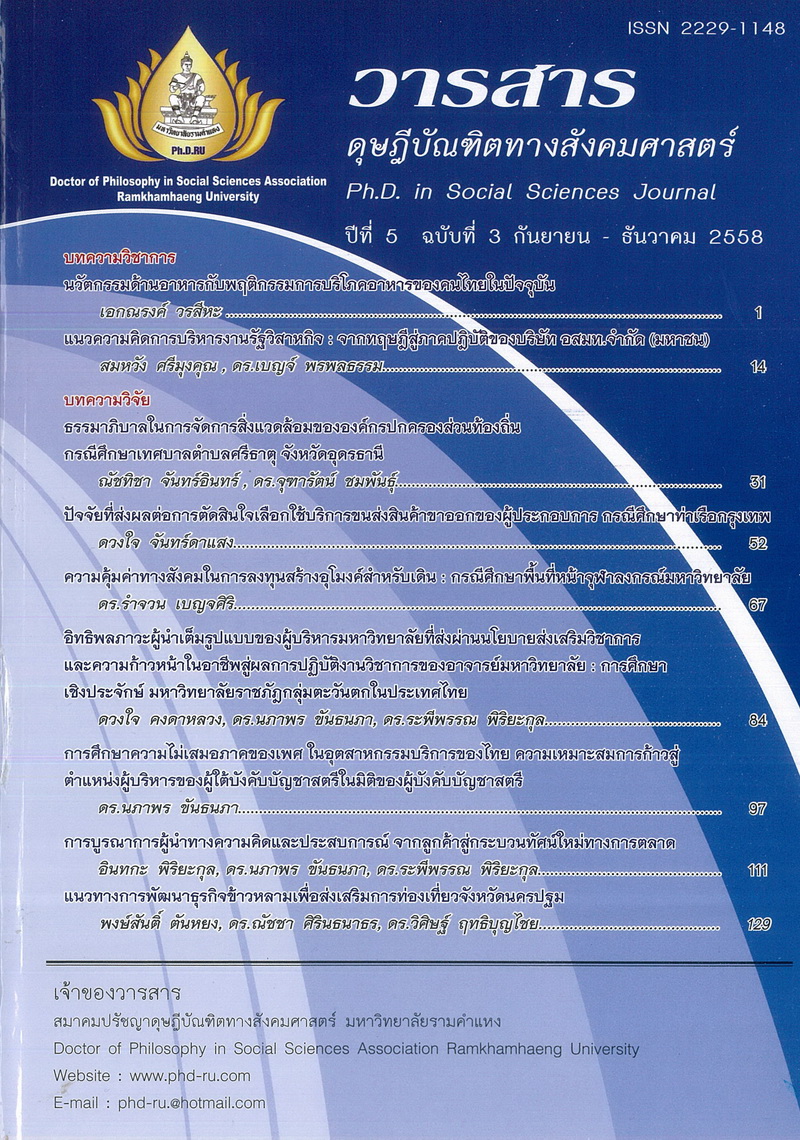ความคุ้มค่าทางสังคมในการลงทุนสร้างอุโมงค์สำหรับเดิน: กรณีศึกษาพื้นที่หน้าจุฬาลงกรณ์มหาวิทยาลัย
Main Article Content
Abstract
การวิจัยนี้มีวัตถุประสงค์เพื่อศึกษาผลประโยชน์และต้นทุนทางสังคมของการสร้างอุโมงค์ลอดถนน สำหรับเดิน และเพื่อประเมินความคุ้มค่าทางสังคมของการสร้างอุโมงค์ลอดถนน โดยใช้พื้นที่หน้าจุฬาลงกรณ์ มหาวิทยาลัยเป็นกรณีศึกษา ข้อมูลที่ใช้ในการศึกษาได้จากการสำรวจพื้นที่และการสัมภาษณ์ผู้ที่เกี่ยวข้อง ซึ่งดำเนินการเก็บข้อมูลในช่วงเดือนพฤศจิกายน 2557 ถึงเดือนมีนาคม 2558
การศึกษาผลประโยชน์ทางสังคมที่ได้รับจากอุโมงค์ลอดถนนใช้แนวคิด Contingent Valuation Method (CVM) และการศึกษาต้นทุนทางสังคมใช้ราคาเงา (Shadow price) ในการปรับมูลค่าตลาดของ ปัจจัยที่ใช้ในการก่อสร้างให้เป็นมูลค่าทางสังคม ผลการสำรวจพบว่า มีผู้ใช้อุโมงค์ลอดถนนหน้าจุฬาลงกรณ์ มหาวิทยาลัย 3,409 คนต่อวัน ผู้ใช้อุโมงค์มีอายุเฉลี่ย 22 ปีเป็นหญิงมากกว่าชาย และส่วนใหญ่เป็นนิสิต นักศึกษา อุโมงค์ลอดถนนมีประโยชน์ คือ ช่วยลดอุบัติเหตุ ลดอันตรายจากการข้ามถนน สะดวกในการ ข้ามถนน ไม่เหนื่อยเหมือนข้ามสะพานลอย และสามารถกันแดดกันฝนได้ อุโมงค์ลอดถนนสามารถลดเวลา ในการเดินทางของผู้ใช้อุโมงค์ไปยังที่หมายได้เฉลี่ย 3.56 นาที การศึกษาพบว่าอุโมงค์ลอดถนนนี้ไม่มีผลเสีย ต่อสังคมและสิ่งแวดล้อม ไม่ทำให้บ้านเมืองไม่สวยงาม ไม่กีดขวางทางเดินบนทางเท้า ประโยชน์ทางสังคม ที่ได้รับมีค่าเท่ากับอรรถประโยชน์ที่บุคคลได้รับจากการใช้อุโมงค์ลอดถนน คือความยินดีจ่ายในการใช้อุโมงค์ ซึ่งมีค่าเฉลี่ย 4.42 บาทต่อคนต่อครั้ง ประโยชน์ทางสังคมของอุโมงค์ลอดถนนนี้มีมูลค่าเท่ากับ 7,698,890 บาทต่อปี อุโมงค์ลอดถนนที่ใช้ในการศึกษามีช่องทางเดินกว้าง 4 เมตร ยาว 40เมตร สูง 3.5 เมตร มีต้นทุน ทางสังคมเท่ากับ 15,063,282 บาท ผลการศึกษาความคุ้มค่าทางสังคมของอุโมงค์ลอดถนนในพื้นที่หน้า จุฬาลงกรณ์มหาวิทยาลัยพบว่า มีความคุ้มค่าทางสังคมสูง สวัสดิการที่สังคมจะได้รับโดยรวมจากการสร้าง อุโมงค์ลอดนี้มีมูลค่า 69,881,175 55,229,718 และ 45,000,776 บาท ในการใช้อัตราคิดลดร้อยละ 8 10 และ 12 ตามลำดับ
Social Return on Walking Tunnel Investment : The Case Study of area in front of Chulalongkorn University
This research aimed to study the benefits and social cost of a walking tunnel and to assess its social return on investment. The area in front of Chulalongkorn University was used as a case study,
The study of social benefits of a walking tunnel were analyzed using the theory of Contingent Valuation Method (CVM) and the study of social costs used shadow price to convert the market price of all factors used for construction to social value. The survey found that there were 3,409 persons used walking tunnel in front of Chulalongkorn University per day. The average age of tunnel users was 22 years. There were more female users than male and most users were students. The benefits that the walking tunnel provided to the users included accidents minimizing, convenience in crossing road, and was not as exhausting as using the overcrossing. The tunnel was also beneficial in terms of keeping out the sunlight and the rain. The tunnel could help users shorten lead-time for traveling to their destinations by an average of 3.56 minutes.
The study found that the tunnel had absolutely no negative impact on the society and the environment. The tunnel did not cause any unpleasant sight to the area and did not block the pedestrian way. The social benefits were equivalent to the utility a person received from using the walking tunnel, which was the average willingness to pay of 4.42 baht per person per time. The analysis showed that the value of the tunnel’s social benefits was 7,698,890 baht per year. The tunnel used in this study with a dimension of 4 meters width, 40 meters length, and 3.5 meters height had a social cost of 15,063,282 baht. The result of the study on walking tunnel in the area in front of Chulalongkorn University showed a high social return on investment. Total social welfare indicated by the net present value from the construction of this tunnel was worth 69,881,175 55,229,718 and 45,000,776 baht at the discounting rate of 8%, 10% and 12% respectively.
Article Details
Academic articles, research articles, and book reviews in the Ph.D. in Social Sciences Journal are author’s opinions, and not the publisher’s, and is not the responsibility of the Ph.D. in Social Sciences Journal Philosophy Association, Ramkhamhaeng University. (In the case that research is done on human, the researcher has to be trained in Ethics for Doing Research on Human Training and has to produce the evidence of the training).


